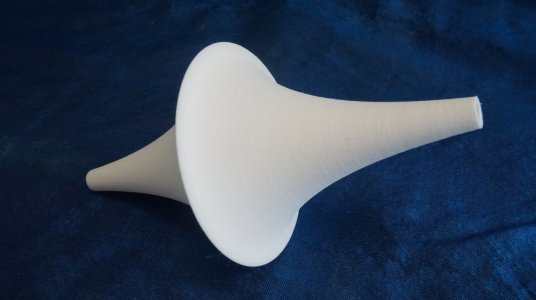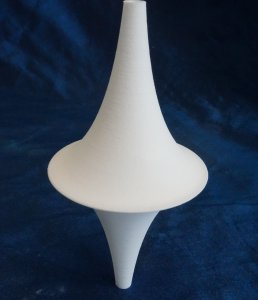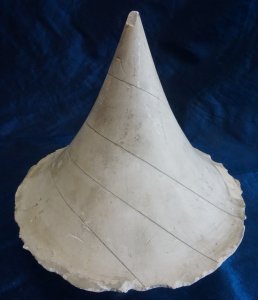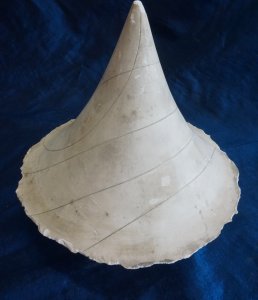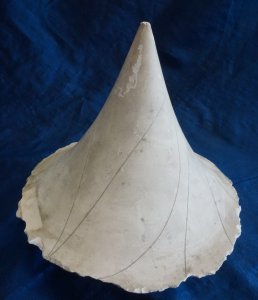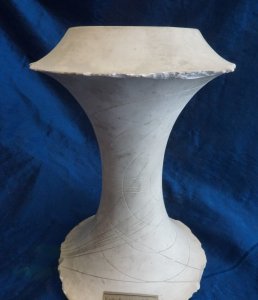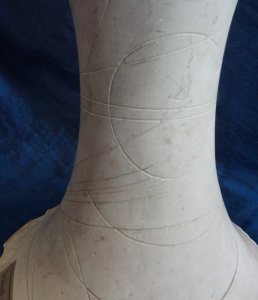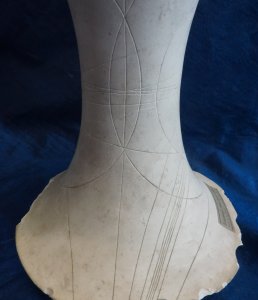Constant Negative Curvature Surfaces of Revolution
Constant Negative Curvature
It can be shown that a surface of revolution of constant Gaussian curvature must satisfy the differential equation $\partial^2 r/\partial t^2 + Kr = 0$. For surfaces of constant negative Gaussian curvature with $K=-1$, their defining function $r(t)$ must be of the form $r(t) = A e^t + B e^{-t}$, where $A, B$ are constants. Such surfaces can take three distinct "shapes", depending on the sign of $AB$, which we shall now briefly investigate before looking at the lines drawn on the models.
For $AB<0$, we have a surface of revolution of constant negative curvature, of the "conic type" (see II 4 below). For $AB>0$, the surface is of the "hyperbolic type" (see II 5 below). These names reflect the similarity in shape with cones and hyperboloids respectively.
For the special case $B=0$, we get a "pseudosphere". Its generating curve is a tractrix, which has many interesting properties. In particular, the tangent to a tractrix always meets the axis with constant length: a tractrix can be realised by dragging a rod by its end, in a straight line. We have a 3D-printed model of the pseudosphere (below). See here for an interesting blog post on the pseudosphere.
Model II 4 - "Conic Type"
This model of the conic type surface displays four geodesics, and an "asymptotic curve". The asymptotic curve on the model is seen shooting up towards the top (see the centre image below) - we discuss these in detail in Asymptotic Curves, while examining a collection of models built specifically to exhibit these curves.
Model II 5 - "Hyperbolic Type"
There are several circles drawn on the hyperbolic type surface (see centre, below). These represent "geodesic circles", which are defined much like a familiar circle in Euclidean space. A geodesic circle with centre $p$ and radius $r$ is the set of all points of distance $r$ away from the point $p$. The difference between these circles and circles in Euclidean space is that they are defined by distances as measured along the surface of revolution. Note also that geodesic lines have constant zero geodesic curvature, while geodesic circles have constant non-zero geodesic curvature. The circles help to indicate the negative curvature of the surface. Imagine peeling (the disc inside) such a circle from the surface. It will not lie flat on a table, rather it will have a "saddle" shape, like the hyperbolic paraboloid.
Geodesic circles, or rather "geodesic balls" (generalisations of geodesic circles and spheres to higher dimensions) to be more precise, determine the Ricci curvature of a manifold. This measure of curvature describes how much the "hyper-volume" of a geodesic ball (or area for geodesic circles) deviates from that of a ball in standard Euclidean space. Ricci curvature has an important role in general relativity, for example in the Einstein field equations.
Also on this model are several geodesics, shooting off in various directions. The geodesics were originally coloured green, but time has faded the colour. There is a meridian, which meets a horizontal line of curvature in the middle. One of the geodesic lines, labelled $l$, has the horizontal line of curvature as an asymptote. This means that as the geodesic continues, it gets arbitrarily close to the line of curvature. Naturally the curve only continues so far before fading away, due to the constraints of drawing on plaster.
This model was designed by Walther von Dyck, who is credited [1] with being the first to define the modern notion of a "group" in 1882. Groups are a hugely important mathematical concept, embodying the notion of symmetry. M.A. Armstrong's book "Groups and Symmetry" provides an excellent introduction to the study of group theory, or for a more light-hearted, recreational introduction to the subject, Marcus du Sautoy's "Finding Moonshine" is a great read.
[show-siblings]
References
[1] Walther von Dyck, "Gruppentheoretische Studien (Group-theoretical Studies)" (1882), Mathematische Annalen 20 (1): 1–44, doi:10.1007/BF01443322





